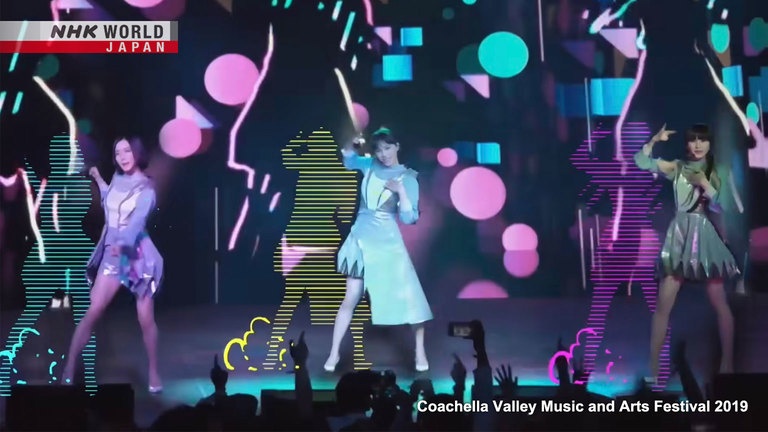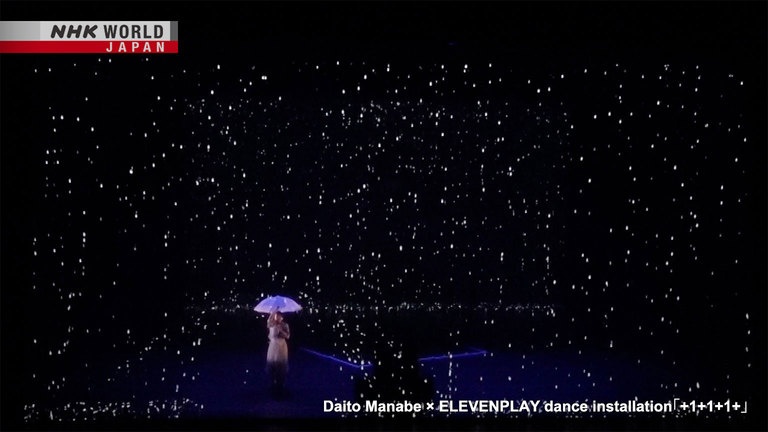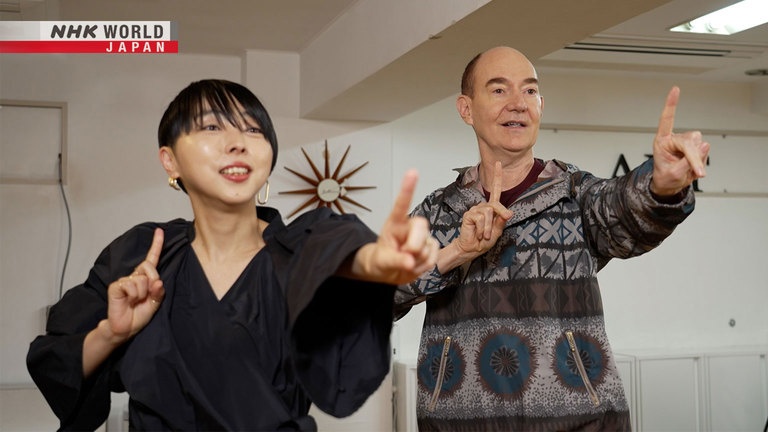MIKIKO: Creating Magic with Dance
Our guest is MIKIKO, a choreographer and director who works with popular groups like Perfume and BABYMETAL. She combines dance with futuristic technology to create soul-stirring performances.



Transcript
Techno-pop trio Perfume.
Metal dance unit BABYMETAL.
Today's guest is behind the choreography for these two popular groups.
- Hello.
- Welcome.
Nice to meet you. I'm MIKIKO.
Choreographer and director MIKIKO.
5, 6, 7, stop. Release is off.
Her productions are a hybrid of physical performance and cutting-edge technology.
Each show aims to provide the audience with a unique experience.
You have to grab them before
they realize what's happening.
Like a low-temperature burn.
We explore the magic that MIKIKO has cast over audiences across the globe.
MIKIKO incorporates state-of-the-art technology to create one-of-a-kind performances.
These Perfume fans are going wild.
But they're actually cheering for a 3D projection.
Suddenly, the real-life Perfume appears on stage, singing and dancing in sync with their 3D-rendered selves.
This footage is from a streamed concert.
Colorful graphics follow the performers' movements in real time.
The production maximizes the use of special effects, incorporating AR technology into live video footage.
This tech can also be seen in MIKIKO's stage productions.
Head-mounted displays and 3D glasses allow the audience to become immersed in the performance.
It's a mixed reality experience in which the lines between VR and real life are blurred.
It's so seamless.
It's hard to tell what came first,
the technology or the choreography.
What are you aiming for?
The body is a musical instrument
that I use to create works.
I try to augment the light and
sound that the body produces.
I want the audience
to sense the invisible.
I want to spark their imagination.
Perfect sync means the body
seems to create light and sound.
That's what I mainly
use technology for.
So technology augments the body.
Yes, but it can only work
if the dancer is skilled.
It takes strength and expression
to harness the technology.
Otherwise, it won't be seamless.
Technology doesn't make life
easier for the dancer.
In my work, the dancer has to be
on par with the technology.
It's more demanding than
conventional staging.
So I'm making life more difficult
for the dancer.
That's tough.
For the magic to work,
the tricks cannot be obvious.
A single millimeter can throw
the whole thing off.
Instantly, the audience feels
let down. The magic is gone.
It demands the utmost
accuracy and precision.
Yet the traditional approach
is that dancers move more freely.
Art lies in the fact that no two
performances are ever the same.
Is that still the case?
Of course, a dancer still
has to be expressive.
She doesn't need lighting to
express the dawn in her movements.
Or to convey her broken heart.
That's a given.
But today we look for more.
Like synchronizing with graphics.
And thus underscoring
the power of human movement.
It's a given that they've mastered
the historic foundation of dance.
Otherwise, they're just
chasing the latest trends.
I don't want that to happen.
My work uses technology, but in
a way that showcases human warmth.
MIKIKO started out as a professional dancer.
When she was 21, she began working with Perfume.
She has choreographed and directed all of their performances since their debut.
Through her work, she has come to embrace the aesthetic concept of "ma,"
rooted in silence, space, and intentional pauses.
As Perfume took off, they began
performing in huge venues.
It happened overnight.
I had to rethink
the meaning of augmentation.
It was vital that the light and
graphics seemed to come from them.
That meant subtracting, not adding.
Maximizing lights before suddenly
going dim helped create focus.
Or adjusting the length of
an interval by 0.5 seconds.
It showcases that this huge venue
is being lit up by just 3 dancers.
It comes as a shock to the audience
when faced with this reality.
I came to realize the importance
of providing such experiences.
I leverage venue size and
emotional reactions in my work.
It's fun to tailor
my work that way.
In 2023, Robert experienced a moment that made him acutely aware of the significance of total silence.
While translating a book on Ukrainian experiences of the war into Japanese,
he visited the war-torn country.
In Lviv, a city near Poland, he met with the manager and artistic director of a puppet theater which dates back nearly a century.
The theater was being used as a shelter for people fleeing the ravages of war.
The manager told me about
the early days of the war.
The theater was full of evacuees.
Families, the elderly.
On the stage, the foyer,
the dressing rooms.
But no one dared to make a sound.
Total silence for 48 hours.
She had never experienced such
silence. It was terrifying.
In Japan or the US, performances
would stop. The focus would be aid.
But she refused to give in.
She began working on a new show
together with the evacuees.
She said she loves the silence
just before the curtain is raised.
The children waiting
with bated breath.
And then the curtain rises
to reveal a magical stage.
The puppets come alive.
That moment is a release for her,
full of energy and joy.
So this new type of silence
was horrifying for her.
The total silence of fear,
not knowing when it would end.
I also love it when the lights
go down before the curtain rises.
It's the best moment.
Why?
Probably because it's an
out-of-the-ordinary experience.
It's a little scary.
A mixture of fear, excitement,
expectation, and other emotions.
I can't say it's the same thing.
But when the lights go down,
there's 5 or 10 seconds of silence.
You have to raise the curtain
at just the right moment.
If you're slow, the audience
will lose concentration.
Too fast, and they won't have
time to build up their emotions.
Timing is everything.
February 2024.
MIKIKO is at work on a new production.
It's for her dance company, ELEVENPLAY.
We wanted to see what we could do
with minimal equipment.
She's aiming for something simple and compact.
In past productions, she's used motion capture sensors to synchronize dancers' movements with video graphics.
This time, however, she's using just projectors and two curtains.
Instead of creating graphics to synchronize with the choreography,
she's asking the dancers to match their movements to the graphics.
You mean you hit the spot
before the music?
5, 6, 7, release.
Is your timing off, Mai?
The dancers have limited time to memorize the choreography and synchronize with the graphics.
Opening day.
This is the last stage rehearsal.
But MIKIKO is not yet satisfied.
Hang on. It's off.
5, 6, 7, stop. Release is off.
MIKIKO says this part needs more work.
The two dancers turn their heads at slightly different times.
The audience will see that the movements are not in sync with the graphics.
MIKIKO aims to create magic by drawing out the optimum physical abilities of each dancer.
5, 6, 7, 8
It's a full house.
The dancers and MIKIKO hype themselves up before the curtain rises.
Lots of energy, please.
The performance begins.
It's the part of the dance MIKIKO was concerned about.
The dancers move in perfect synchronicity with the graphics.
The performance is a success.
A hit song by singer-songwriter Hoshino Gen, with choreography by MIKIKO.
The song went viral in Japan, and social media was flooded with videos of people performing the dance.
How do you choreograph
a dance for a song?
I first read the lyrics and
allow the words to sink in.
The words linger in my mind.
But the audience won't see them.
So when Hoshino sings about
what's in his heart, I do this.
To convey a beating heart.
The viewers may not get it, but
I always try to express the lyrics.
- Want to try dancing?
- I'll try.
This is the segment Robert will learn.
The right hand forms a circle
above. The left hand is below.
They come together in front,
and hold up one finger.
Ready?
Thank you.
Well done.
You see people doing this when
passing in front of someone.
Japan is full of such gestures or
movements that convey a message.
Do you incorporate such gestures
into your dances and choreography?
- Yes, all the time.
- Like what?
The "be quiet" gesture.
I also incorporate childish movements
to add a little charm.
Then, there's the thinking gesture.
Or this gesture.
So, I incorporate
a lot of everyday movements.
Traditional stylized movements
are called "shosa."
In the Edo period, there were
"shosagoto" dances or dance-drama.
Dancers had to follow these
stylized movements with precision.
These movements were "shosa."
The tea ceremony has its own
set of stylized movements.
Constant repetition and practice
of those movements...
It began to feel elevating.
Almost like a spiritual practice.
Like you're in a trance.
Perhaps that's how some dance began.
Japan probably has more schools of
dance than any other country.
There are so many different schools,
even in traditional Kyoto dance.
Annual events all have
an element of dance.
Bon dances are seeing a revival,
with many new dances being created.
Is there anything unique
about Bon dances?
They consist of simple,
primitive movements.
They foster a sense of community,
repeating the movements together.
They form either a circle or a row.
Yes, it's a group dance
without any solos.
It's a group effort.
Some things can only be expressed
through dance.
Dance can express emotion directly:
anger, sadness, or pain.
But I don't like to be direct.
I prefer to be allusive.
Allusive?
It's like a low-temperature burn.
You have to grab them before
they realize what's happening.
Something hidden is more
tantalizing than a direct reveal.
It's what makes a kimono sensuous.
It restricts the way one moves,
which makes it so alluring.
I like to allude to the depth of
emotion that is hidden within.
The word you used was "koboreru,"
which is hard to translate.
The literal meaning, "to spill,"
just doesn't cut it.
It implies that you accidentally
spilled something and made a mess.
No, it's more positive.
It's more poetic.
It's like a sky full of stars.
A flower about to burst into bloom.
It has an underlying passion to it.
My area of expertise is
classic Japanese literature.
A key aspect is that emotion
is alluded to, rather than shown.
'Low-temperature burn'
is a great way to put it.
In 2021, MIKIKO choreographed a dance as part of a project to promote diversity as well as the UN's sustainable development goals.
"If we're able to keep going hand in hand"
Her choreography connected people the world over.
"We will be laughing and living together with a smile."
"I'm thinking of what I can do to make it better now"
MIKIKO has spearheaded the Japanese entertainment industry, bringing magic to the stage.
What are her thoughts on the future of entertainment in Japan?
Japan's entertainment industry
is at a crossroads right now.
What's your take on this?
Well... Some do think
that it's facing a crisis.
Japan is very accepting
and aware of trends.
People tend to follow those trends.
So I suppose I would say...
I feel it's important for
performers not to be swayed by this.
To walk their own path.
We all need to be aware of our role
in keeping the industry alive.
Japan is painfully aware
of global expectations.
This goes for art as well.
But Japanese entertainment seems
to stand alone. Self-contained.
It's important to create works
with international appeal.
But not at the cost
of losing its Japanese identity.
It's a tough line to walk.
- But we're failing at it.
- I agree.
Our historical dance culture is
superb: kabuki, Noh, bon dances.
But what about a century from now?
What will remain from today?
Most people would struggle
to answer that question.
Modern dance culture cannot thrive
without the support of others.
Producers, authorities, people
willing to go the extra mile.
I never thought I'd come this far.
ELEVENPLAY, Perfume, and BABYMETAL
have come far thanks to fans.
I hope to preserve this scene in
a tangible form for the future.
Maybe start archiving it properly.
I hope to reflect on the past
as I look towards the future.